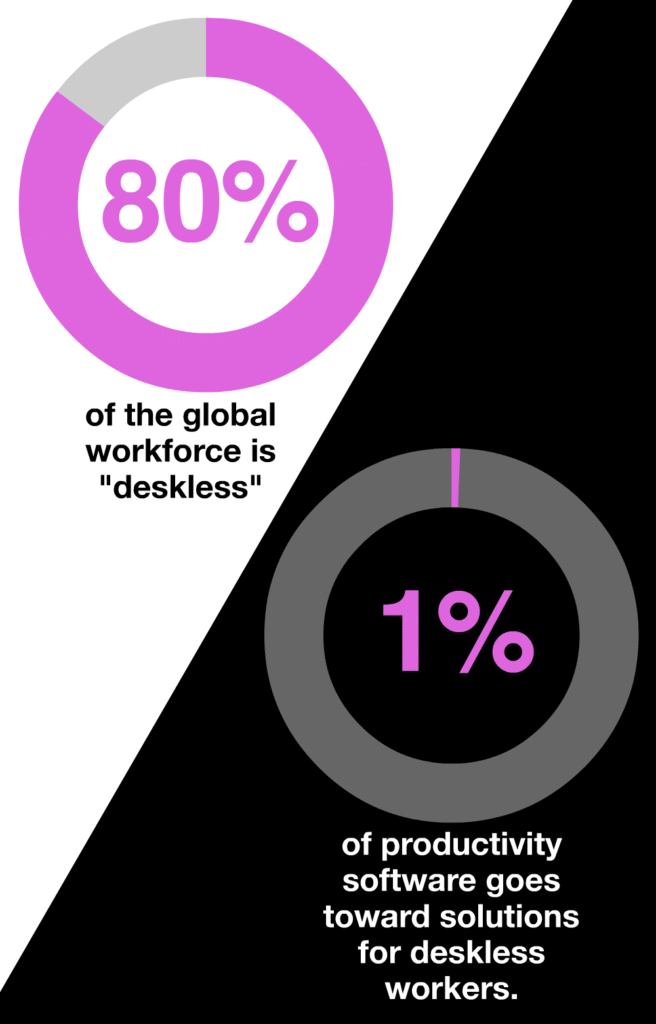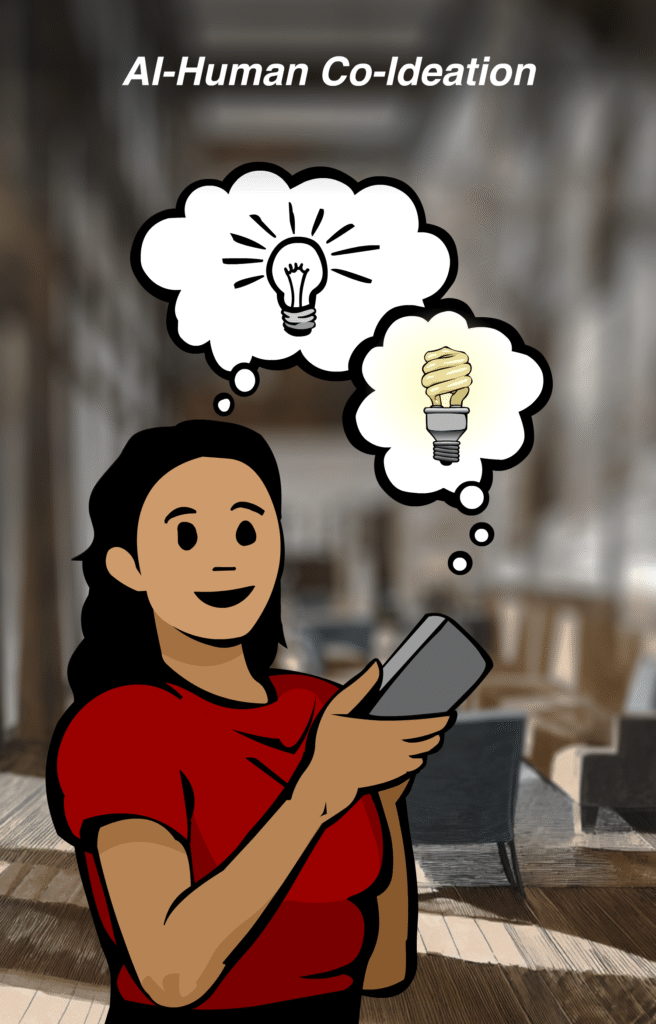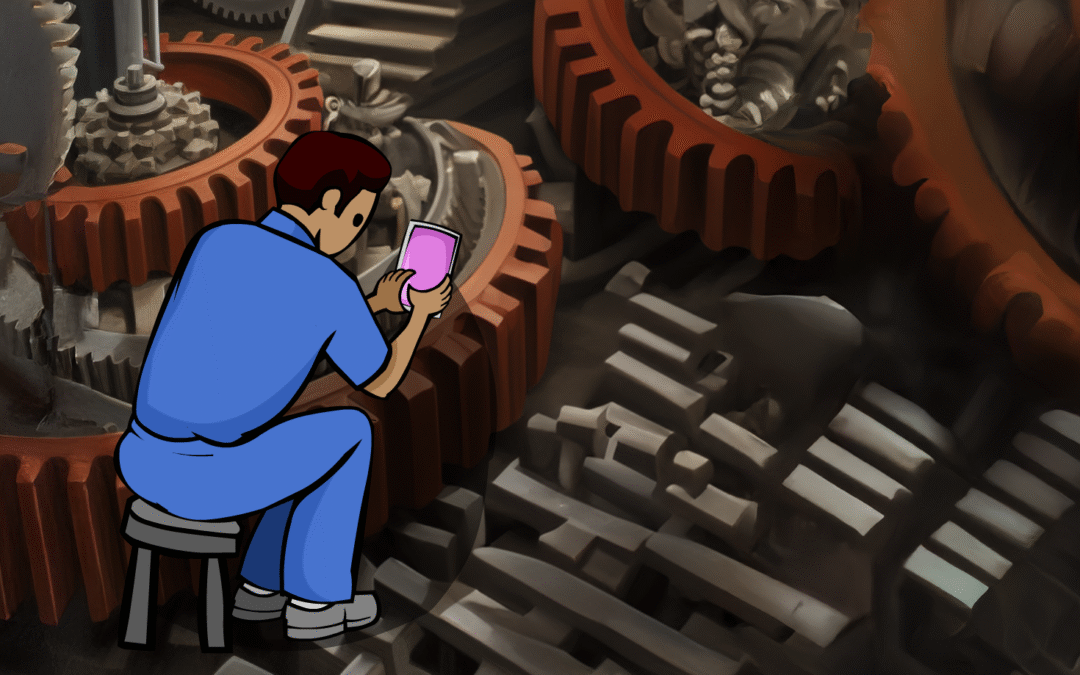80% of the global workforce do not work at a desk: they are drivers, loaders, builders, retail workers and service employees. But this group receives less than 1% of annual productivity software investment. Despite their critical roles and harsh conditions, they face major challenges: limited tech, poor communication, unpredictable schedules, and low levels of engagement. AI-Powered tools, mobile and voice-activated, offer a powerful solution for instant support in the field. AI training for this vital group is the single biggest ROI of any worker in your working community.
Fiona Passantino, AI Leadership
The forgotten majority
There are 2.7 billion employees around the world who don’t work at a desk every day.[i] Think about service technicians, factory workers, construction crews, delivery drivers, warehouse staff, field sales teams and retail employees. These forgotten workers are found in every sector, and at every level.
Whether they’re operating trucks, managing inventory, performing maintenance, or delivering services, deskless workers need their hands to do manual labor, and do not sit at a desk. They are the backbone of operations, keeping businesses running and customers happy. And they represent about 80% of the global workforce.[ii]
And yet, of the €255 billion that is spent on productivity software each year, only 1% goes toward solutions for deskless workers.[iii] Meanwhile, 70% of field workers feel that more technology would help them do their jobs better and more efficiently.[iv]

What are their biggest challenges?
Deskless workers have high-stress, physical jobs. They often work for lower pay, do their jobs alone and are exposed to the elements, without the benefit of physical colleagues or support from a line manager.
This group shows traditionally low levels of engagement and high turnover. Just 72% of deskless workers trust their employer, compared with 81% of desk-bound and 89% of executives.[v] The turnover rate is alarming among deskless workers, at 36% annually, as opposed to around 20% for the global average.[vi]
What are some of the biggest challenges they face in the field?
Shift work: Deskless workers generally still appear in shifts, some rotating across 24/7 schedules. Shifts can change every week based on availability and demand, making it hard for employees to care for family members and maintain regular sleep cycles. Deskless workers crave flexibility and the ability to manage their time quickly, often listing it as more important than overall compensation.[vii]
Communication: While the desk-bound literally drown in internal messaging, deskless workers are out of the loop. Most communication is email or portal-based; deskless workers have neither time, free hands nor the company-issued Dell they need to access it. Leaders are also unsure how to communicate with this group and leave it to mid-level managers to “cascade” relevant messages down the line. We all know how this goes: anyone ever play a round of “telephone”?
Listening: Office workers have many ways of conveying their ideas, problems or concerns up the chain, and this is easily documented and turned into user stories, straight for the backlog. Headquartered employees have access to live Town Halls, team meetings and team-building trips, while the deskless feel unheard and misunderstood.
Training: When it comes to professional development and career advancement, desk-bound employees can tap into knowledge libraries, internal webinars and live training events, while deskless workers are left behind.
Some 62% of deskless workers are unsatisfied or reported there is room for improvement in the tech they use to perform their jobs causing 56% to use their own technologies to fill the gaps.[viii]

The AI-powered Deskless Employee
The good news is there are ways to meet all these challenges with AI. The same training and support that desk-bound workers receive for AI in 2025-2026 will be very compelling and even more dramatic for the deskless workforce.
There are 7.21 billion smartphones in the world, which means that 90% of the 8 billion Humans are likely holding one right now.[ix] The same intelligence that fills our desktop computer screens can be accessed by smartphone app as well. The keyboards used to prompt writing can just as easily be a voice-activated workflow for quick AI-Power on the go, on location, on the road, hands-free.
Deskless workers need to solve problems quickly, flexibly, on the go, often in unpredictable environments. Here are a few easy ways AI can help:
- Log an inspection report by speaking into a phone while driving back from the site visit. Do this as soon as the visit ends, while all the information is top of mind.
- Ask for instant troubleshooting steps without scrolling through a manual.
- Translate a customer’s request from one language to another in seconds.
- Using AI Vision to upload and analyze a photo of a problem on location and get automated verification or quality checks in real time.
- Get access to databases of customer information, product availability and their locations, advice and service as well as ways of communicating this on the go.
- Benefit from personal coaching for interpersonal stakeholder management issues with team members or line managers or receive neutral career and training advice to take on personal development actively.
- Simplify administrative tasks like paperwork, inventory updates, or scheduling by voice and photo.
- Set up basic AI agents to automate repetitive tasks, that come with you on the move.

AI Training for the deskless
It’s a myth that deskless workers are “old school”: 70% of this group belongs to Generation X, Y, and Z, making them “digital natives.” They’ve grown up with technology and are far more comfortable using AI than their mid-level counterparts.[x]
AI is perfectly designed to solve the challenges faced by deskless workers. Providing access to bot-assisted internal communication channels for company messaging or email converted to conversation improves internal communication and engagement for everyone.
Spoken AI can also give the deskless access to large, in-company events to help connect with colleagues and management, ask questions, and share feedback. AI gamification solutions can make admin and logging less of an eye-rolling drag. Personalized AI trainers are nice for flexible, voice-based training sessions on the go, fitting into irregular schedules.
Small Language Models built in-house or internal APIs are portals to institutional knowledge, offering information and expertise from previous employees and legacy workflows.
We all know that motivation and engagement reduce employee turnover. Focusing on this demographic does more than reduce your HR recruitment costs; it sends a powerful message that everyone at a company matters and is worth the investment. AI training and solutions build a positive workplace culture that encourages growth, and signals that an organization lives at the cutting edge across all verticals.
Every employee in your company is a member of your working community, whether they are in the field or behind a screen. AI training specific to your deskless force has the potential to provide a far more dramatic ROI than the same investment made for the desk-bound, simply because digital tutorials are already widely available to the office worker, and often free. Desk-bound have more opportunities to practice prompting AI and experiment with multimodal solutions than workers in the field.
AI training for deskless employees is a crucial part of your organizational AI Integration Roadmap, making every member feel supported, seen and connected; in short, AI-Powered.
Need help with AI Integration?
Reach out to me for advice – I have a few nice tricks up my sleeve to help guide you on your way, as well as a few “insiders’ links” I can share to get you that free trial version you need to get started.

No eyeballs to read or watch? Just listen.
Working Humans is a bi-monthly podcast focusing on the AI and Human connection at work. Available on Apple and Spotify.

About Fiona Passantino
Fiona helps empower working Humans with AI integration, leadership and communication. Maximizing connection, engagement and creativity for more joy and inspiration into the workplace. A passionate keynote speaker, trainer, facilitator and coach, she is a prolific content producer, host of the podcast “Working Humans” and award-winning author of the “Comic Books for Executives” series. Her latest book is “The AI-Powered Professional”.
[i] Ritter (2020) “The State of Technology for Deskless Workers” Emergence Capital Partners https://www.emcap.com/technology-for-the-deskless-workforce-2020
[ii] Dhar, Lovich, Mattey, South, Takeuchi, Ullrich, (2024). Why Deskless Workers Are Leaving – and How to Win Them Back. Boston Consulting Group https://web-assets.bcg.com/pdf-src/prod-live/why-deskless-workers-are-leaving-and-how-to-win-them-back.pdf
[iii] Thadani, Turkington (2020) “Voice Tech’s New Job: Serving the Deskless Workforce” Nasdaq. https://www.nasdaq.com/articles/voice-techs-new-job:-serving-the-deskless-workforce-2020-12-16
[iv] Ritter (2020) “The State of Technology for Deskless Workers” Emergence Capital Partners https://www.emcap.com/technology-for-the-deskless-workforce-2020
[v] Corfman (2023) “Filling the trust bucket of deskless workers” Ragan https://www.ragan.com/how-to-fill-the-trust-bucket-of-deskless-workers
[vi] Merritt (2024) “Staff Retention in 2024: Global Stats and Trends” Merritt Blog https://www.merrittrecruitment.com/blog/2024/07/staff-retention-in-2024-global-stats-and-trends
[vii] Moran (2024) “The Top 7 Challenges Deskless Workers Face” Workforce Blog https://workforcesoftware.com/blog/top-7-challenges-deskless-workers-face/
[viii] Waern (2022) “Here’s Why Deskless Workers Need Better Tech In 2022” Forbes Magazine https://www.forbes.com/councils/forbestechcouncil/2022/05/18/heres-why-deskless-workers-need-better-tech-in-2022/
[ix] Howarth (2025) “How Many People Own Smartphones? (2025-2029)” Exploding Topics https://explodingtopics.com/blog/smartphone-stats
[x] Yan (2023) “The top 7 challenges when training deskless workers” Simpplr Blog https://www.simpplr.com/blog/2023/challenges-training-deskless-workers/

